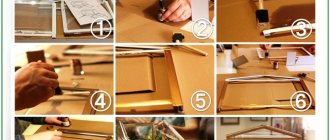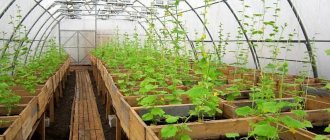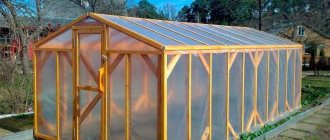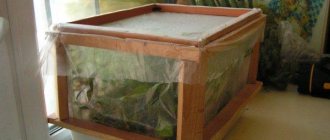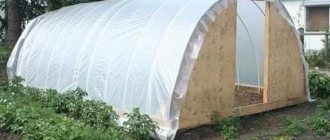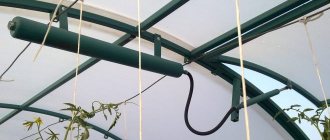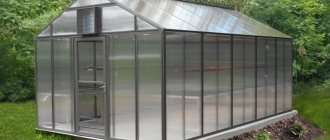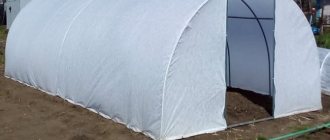A greenhouse and a mini-greenhouse for seedlings are indispensable assistants for every gardener. In specialized stores they are not cheap and do not always fit in size. Therefore, the ideal option would be to make mini-structures with your own hands. The article will provide detailed instructions on how to do this quickly and with minimal financial costs.
What you need to know about greenhouses
Purpose
Like a greenhouse, a greenhouse is used to create a favorable microclimate when preparing seedlings or when fully growing tomatoes, cucumbers, cabbage and other plants.
In a broad sense, both structures are perceived as the same thing, although in fact a greenhouse is a small and unheated structure. A greenhouse is a larger building with a heating and ventilation system, which allows for the cultivation of many crops at any time of the year.
Design
The structure of greenhouses is quite simple. A frame is assembled from pipes, metal or wood, which is covered with film, polycarbonate, glass, acrylic and other light-penetrating materials. If the weight of the structure is very large, it is additionally installed on the foundation.
For ventilation, removable panels or opening transoms are provided. Heating is carried out using water heating with radiators, infrared heaters or hot air from heat sources outside the greenhouse.
Installation
Since sunlight is vital for plants, the greenhouse should be built on the south side. It is advisable to place it on a slope and closer to other buildings in order to protect it from the wind and have access to utilities. It is better to stay away from high fences and trees: they provide shade, and falling leaves reduce light transmission.
General requirements
When manufacturing any greenhouse, the following conditions must be met:
- good light conductivity;
- free access to plants to care for them;
- the possibility of ventilation of the internal space of the greenhouse;
- strength;
- aesthetics is an important quality, especially when it is at home, beauty always inspires.
Place for a mini-greenhouse
The place in the apartment for a mini-greenhouse should be chosen taking into account the time of year, the illumination of the place, or the possibility of installing additional lighting there. A good solution would be to place it on a glazed loggia .
How to make a greenhouse with your own hands from agrofibre and reinforcement
youtube.com
- Assembly complexity: low.
- Foundation: not required.
- Cost: low.
- Variations: the frame can be replaced with plastic pipes, and the covering material with film.
The simplest design option, which is ideal for a small greenhouse. A frame made of reinforcement is installed directly on the bed, and agrofibre or, as it is also called, spunbond, is stretched over it. This material protects from the sun while retaining heat and moisture.
1. The dimensions of such a greenhouse are chosen arbitrarily, depending on the footage of available materials. For example, it is convenient to cut six-meter reinforcement in half. With such a length of arcs, the width of the greenhouse is about 80 cm. The arcs themselves should be installed in increments of 1.2–1.5 m.
teplica-exp.ru
2. Arcs are bent from reinforcement with a diameter of 8 mm. Next, drip irrigation tubes or an old hose are put on them, leaving 10–20 cm at each end so that it is convenient to insert the structure into the ground.
ebayimg.com
3. After marking the installation locations for the arcs, scraps of steel pipes or drilled wooden pegs 20–30 cm long are driven into the ground, and the reinforcement is inserted into them.
stopdacha.ru
4. Spunbond can be stitched on a sewing machine, forming pocket folds that fit directly onto the arches. Another option is to install plastic pipe guides on the sides of the beds and attach agrofibre to them using purchased clips or cut pieces of pipes. The covering material can eventually be easily lifted by simply removing them.
stblizko.ru
5. If desired, you can attach the arcs not to pipes driven into the ground, but to metal guides rigidly fixed at the edges of the base. This design will allow you to fold the greenhouse like an accordion, simply by moving the arcs.
must.kz
6. The free ends of the spunbond at the ends must be collected, tied in a knot and secured with a peg, earth or other means.
samara.kinplast.ru
Here are step-by-step video instructions.
Organization of lighting and watering
Regardless of what you plan to grow on the loggia - seedlings, herbs or vegetables, it is important to take care of the correct microclimate
What lighting is suitable for a balcony greenhouse
A balcony greenhouse requires additional lighting in the spring months. In April-May, daylight hours in the middle zone are not long enough for the development of subtropical plants (tomatoes, eggplants, sweet peppers). Artificial lighting is especially important for balconies oriented in the north and northwest directions.
Industrial phytolamp
The most economical type of artificial greenhouse lighting is LEDs. It is they, in a certain combination of colors, that make it possible to achieve the spectrum necessary for normal plant growth, which is close in wavelength to sunlight.
The cost of purchasing components for making a “phytolamp” with your own hands is approximately 2-2.5 times less than when purchasing a finished product.
The power of the phytolamp is calculated based on the data on the packaging of the finished product, which indicates the lighting area. For self-production - by calculating the total power of the LEDs used. A typical LED combination is 2/1/1 where: 2 – red LEDs, 1 – blue LEDs, 1 – additional LEDs (UV, IR, green, white).
Homemade phytolamp is several times cheaper
When installing an artificial lighting system, take care to carefully waterproof the tiers in the greenhouse. So that excess water flowing out of the drainage holes in the bottoms of the pots does not fall on electrical appliances.
Drip irrigation device
For trouble-free watering of seedlings in a greenhouse on the balcony, so as not to break or damage the stems, the plants should be watered from a tray or using a drip irrigation system. The second of the systems is more convenient, since it allows you to significantly automate the process and thereby reduce the time for caring for plants.
On the balcony you can install either a manual system, which requires placing a container of water above the level of the plants, or an automatic one. In this case, the barrel can be located on the floor or anywhere else in the loggia.
Drip irrigation device diagram
When installing an automatic watering system, a small submersible pump is used, a large assortment of which can be found in gardening equipment stores in the departments that sell indoor and garden fountains.
Considering the small volume of balcony greenhouses and the modest water needs of plant seedlings, tubes from medical diffusion systems - “droppers” - are quite suitable for assembling a drip irrigation system. Connections for them can be purchased in the aquarium department of any pet store. The on/off programmer is the simplest electronic relay made in China, costing 250-600 rubles.
A greenhouse or greenhouse on the balcony is indispensable for lovers of gardening and home floriculture.
How to make a greenhouse with your own hands from masonry mesh and film
dachadecor.com
- Assembly complexity: low.
- Foundation: not required.
- Cost: low.
- Variations: instead of film, you can use agrofibre, and make the door on a wooden frame.
A budget option for a greenhouse made from masonry mesh and regular film, which is quickly assembled and has a number of advantages. The design does not require a foundation; due to its elasticity, it is resistant to wind loads, and is also convenient for tying up plants from the inside. At the same time, by folding the mesh, you can get different sizes depending on your needs.
- Wooden beams, steel angles, pipes or channels are used as load-bearing posts. They are hammered at a distance of 1.2–1.4 m.
- The greenhouse arch is formed from two pieces of mesh laid overlapping. From below it is attached with wire to the posts, and from above it is fastened together with the same wire or plastic ties.
- To strengthen the structure, T-shaped supports made of wooden beams 50 × 50 mm are installed in the middle of the passage. If desired, they can also be driven into the ground.
- A film is put on a dome assembled from a mesh, which is held in place by strings of twine or rope stretched over it.
- The side walls are also made of film, which is folded up and attached to the dome with tape. In several places at the top and bottom, small windows are cut for ventilation of the greenhouse.
- The door is made on a wooden frame or made from the same film, which is cut and attached to the side wall with magnets in the manner of door mosquito nets.
Types of small greenhouses
There are different mini-sized greenhouses:
- By type of design: wall-mounted, rounded, with straight side walls, Dutch, portable, cabinets.
- Purpose: home-type greenhouses for seedlings, for seed germination, for domestic plants that require special treatment, portable type for seedlings, small capital greenhouses for cultivating various crops.
Miniature greenhouses can be equipped with local heating, ventilation and lighting.
The use of such structures gives firm confidence in the ability to grow fastidious, heat-loving vegetables and flowers, will speed up the growth of seeds and seedling growth, and will also speed up the fruiting time by 1-2 weeks.
How to make a greenhouse with your own hands from stretch film with a wooden frame
stroydachusam.ru
- Assembly difficulty: average.
- Foundation: not required.
- Cost: low.
Another way to quickly build a greenhouse. A wooden beam is used as a frame, and stretch packaging film is used as a covering material. With a large number of layers, it transmits light a little worse than ordinary PVC film, but on hot days this is even a plus.
- The film is sold in rolls, so the dimensions of the greenhouse are selected according to the cutting of the timber and taking into account your wishes.
- For the base, steel corners 40 × 40 mm are used, in which holes for attaching the frame posts are pre-drilled. They can also be treated with bitumen or painted to extend their service life.
- The corners are driven into the ground, and pieces of timber are screwed to them with self-tapping screws. A lower frame, in turn, is attached to the beam, on which the side walls and roof are assembled. All corners are reinforced with additional inclined sections of timber.
- The door is assembled on a wooden frame in one of the side walls and installed on hinges.
- Film wrapping is done in parts, in several layers and overlapping. First, the gables are installed, then the roof slopes, and only then the walls. You need to start wrapping them from the bottom so that running rainwater does not get inside the greenhouse.
- After wrapping with glazing bead or river, the door and its outer contour of the door are trimmed, and then the film around the frame is cut through. In the same way you can make a window in the opposite wall.
How to build a simple greenhouse for seedlings
If this is your first time thinking about how to make a greenhouse yourself, then the simplest model with a pitched roof will do. This box is made of wood or polycarbonate. Since the greenhouse is installed on the floor or cabinet, and then containers with seedlings are placed in it, the bottom is not made in the box. This is also convenient for using the structure in the country - the box is simply installed on the garden bed.
Tools and materials for manufacturing
It is better to make a greenhouse with your own hands from high-quality boards - this way its service life will be long, and if necessary, it can be disassembled and reassembled. So, you will need:
- boards 20 mm thick (the number and length are calculated based on the size of the greenhouse);
- timber 40x40 mm;
- rail 20x10 mm;
- window beads for fastening glass to the frame;
- loops for fastening the frame;
- glass or polycarbonate according to the size of the folding frame – 2 pcs;
- insulation material;
- locking hooks and loops for hooks;
- self-tapping screws or self-tapping screws;
- glass cutter;
- saw;
- screwdriver or screwdriver;
- oil paint or enamel, a means to protect wood from rotting.
A lean-to greenhouse with a glass or polycarbonate frame is suitable for balconies and gardens
Preparation for greenhouse installation
First of all, to install a small greenhouse on the balcony, you need to choose a suitable place. Please note that the plants will need to be looked after, so access to them should be convenient. Also check the lighting conditions - on southern balconies the box can be placed along any wall; in other cases, position the greenhouse so that the plants are well lit in the first half of the day.
Then decide on the dimensions of the box and draw an auxiliary marking drawing
Be sure to pay attention to the presence of insulation - if you cover the outside of the box with foam plastic, then immediately include an allowance for the covering in the dimensions. If this is not done, then the finished box may simply not fit in the allocated space
If desired, a wooden greenhouse with a glass lid can be made double
Think carefully about the system for draining excess water. If these are trays with seedlings, be sure to place them on pallets. If you plan to simply line the inside of the box with film into which the soil will be poured, then make sure that the floor on the loggia is lined with ceramic tiles and has a slight slope towards the street (for water drainage).
Step-by-step assembly of a greenhouse
After all the preparatory work, you can begin installing the greenhouse.
- Mark and cut out the parts according to the drawing:
- 2 front pillars;
- 2 high rear pillars;
- 4 parts for a folding frame (made of 40x40 timber);
- boards for lining the box.
- Treat wooden parts with an anti-rot agent and paint.
- Attach the boards to the racks with self-tapping screws or self-tapping screws.
- Cover the box with thermal insulation.
- Fasten the bars for the frame end-to-end. If possible, immediately cut grooves for installing glass on both sides of the frame (top and bottom). If not, then place glass or polycarbonate on the frame (the sheet size is 40 mm smaller than the finished frame) so that there is 20 mm left on each side to the edge of the frame.
- Attach a 20 mm rail around the perimeter of the frame. You will get an improvised groove.
- Secure the glass with glazing beads. Then do the same actions with the bottom side of the frame. To help the frame retain heat better, place a layer of window putty under the glass on the frame.
- Place the frame on the box and screw the hinges to its back wall.
- Attach locking hooks to the top of the rear pillars. You can make hooks of different sizes - long ones for fixing the frame during ventilation, and short ones for attaching the lid while caring for seedlings.
Single-pitched polycarbonate greenhouse on a table-stand
The same greenhouse can be assembled entirely from polycarbonate. Wooden blocks, plastic pipes or a metal corner are suitable as connecting posts. The finished greenhouse can be installed on the balcony on the floor or on a special table.
Mini-greenhouse on site
How to make a greenhouse with your own hands from old window frames
teplica-piter.ru
- Assembly difficulty: average.
- Foundation: desirable.
- Cost: minimal.
- Variations: you can combine frames with film to make a roof, side walls or doors.
The main advantage of this design is its low cost. Old window frames can be found, if not free, then for a nominal price. In addition, glass transmits light much better than film and polycarbonate. The windows already have vents for ventilation, and if you select a balcony block, you will also have a ready-made door.
- The size of the greenhouse depends on the size of the frames and the interior space you need. Aim for a width of about 2.5 m to give a passage of about 60 cm and two beds of 80–90 cm.
- Windows and glass have considerable weight, so it is advisable to install them on a solid base. This can be a shallow strip foundation, a massive wooden beam or a metal profile.
- A wooden frame or pillars are installed on the foundation at the corners, and frames are attached to them and to each other. The gaps between each block are covered with putty and clogged with strips of laminate backing or a thin wooden strip.
- A door is made in the front wall. Its role can be played by one of the windows, a balcony door or a wooden frame covered with film. Ventilation is provided through window vents.
- To reduce weight, it is better to make the roof from wooden beams and film. You can use the same window frames, but in this case you will have to reinforce the structure with supports in the middle of the passage so that it can withstand a lot of weight.
Making your own greenhouse
Not every apartment owner can afford to buy a miracle greenhouse, since choosing the most popular models is associated with certain costs. At the same time, industrially manufactured mini-greenhouses are in great demand on the market. Greenhouses allow you to achieve excellent results associated with growing seedlings. Even with minimal care, the harvest in a mini-greenhouse on the balcony will always please the owners.
The main advantage of the design is protection from direct ultraviolet radiation. Using a greenhouse allows you to provide the necessary microclimate for plants. Without the use of mini-greenhouses on the balcony, it is very difficult to grow seedlings on time, so many enterprising gardeners began to grow seedlings for sale. Various types of greenhouses for a glazed balcony allow you not only to survive the crisis, but also to make money by selling seedlings.
In this case, it is necessary to choose the best option to resolve issues related to the location of the greenhouse on the balcony. The greenhouse should allow for cleaning and window washing. You should take care in advance of a convenient passage and seating area. This will make it possible to provide full care for the plants, especially when the balcony is on the south side. If you need to strictly observe all the dimensions of the structure for a more convenient arrangement of the balcony, then you can make a mini-greenhouse with your own hands.
How to make a greenhouse with your own hands from film and polypropylene pipes
maja-dacha.ru
- Assembly difficulty: average.
- Foundation: not required.
- Cost: low.
- Variations: the film can be replaced with agrofibre or polycarbonate
A greenhouse made of polypropylene pipes attracts with its simplicity, reliability and low price. The materials are sold at any hardware store, and assembly does not require any special skills or tools. You can even do without a soldering iron if you connect the pipes not with fittings, but with through bolts.
- As always, sizes are selected based on needs and available materials. Polypropylene pipe is usually sold in 4 m sections, and it is easy to cut and splice using couplings.
- The first step is to calculate the length of the pipe and the number of fittings required. It’s better to take it with a reserve so that you don’t have to run to the store later.
- The main parts are soldered from pipes, tees and crosspieces - arches with crossbars and longitudinal inserts.
- Next, the greenhouse is assembled from the prepared parts. If a soldering iron is not at hand, you can use bolts with nuts and washers to connect, which are inserted into pipes drilled through.
- The film is secured to the edges of the frame using purchased pipe clamps or homemade clips made from slightly larger diameter pipes cut along sections.
Sliding greenhouse design
From aluminum and PVC pipes, which can be purchased at a plumbing store, you can make a retractable roof for a greenhouse. In addition to pipes and boards for the box, you will need to buy plastic plumbing tees.
Two metal guide pipes are installed along the wooden box. Plastic tees are put on the pipes; the diameter of the pipe should be slightly smaller than the diameter of the tee so that the parts slide easily. Long, flexible PVC pipes are inserted into the tees and bent in an arc. The film is stretched over the structure and secured with a PVC hoop, as described above.
The retractable roof allows you to cover the plants in early spring and leave them to grow in the open air in the summer; there is no need to replant them.
Making a greenhouse with your own hands is not at all difficult. To get inspired by ideas, look on the Internet for photos of DIY greenhouses. To work, you will need improvised materials that you can find at home or very inexpensive wood or plastic from the nearest hardware store.
How to make a greenhouse with your own hands from film with a wooden frame
legkovmeste.ru
- Assembly difficulty: average.
- Foundation: not required.
- Cost: low.
- Variations: the film can be replaced with agrofibre or polycarbonate.
A classic version of a greenhouse, used for decades and not losing popularity. Wooden beams are easy to process, have low weight and sufficient strength, and also retain heat well. The structure does not require a capital foundation - you can get by with a frame made of timber of a larger cross-section or use steel corners as a base.
- The standard cutting of timber is 6 m, so they start from this figure. Most often, greenhouses are made 3 × 6 m, but if desired, the dimensions can be either reduced or increased. The finished project with material calculations is available at this link.
- The assembly of the frame is the same as for a greenhouse made of stretch film. Steel corners are driven into the ground at intervals of about 1 m at the points where the posts are attached. In each of them, two holes are drilled for self-tapping screws or one for M8 or M10 bolts.
- Vertical posts are fixed to the corners along the entire perimeter, which are tied with an upper contour made of timber. To add rigidity in the corners, one jib is added on each side
- Triangular roof trusses are installed and secured opposite the racks. The slope angle is selected depending on the snow load. So, if there is a lot of snow in your region, the angle of inclination should be greater (the roof is higher and sharper).
- The door and window for ventilation are assembled on wooden frames and installed in the front and rear walls, respectively.
- At the end, the frame is covered with film, which is attached to the beam using a lath stuffed on top. All sharp parts on the wood are rounded off or covered with a soft material so that the film does not tear during operation.
Lighting organization
Typically, seeds for seedlings are planted at the end of winter or early spring. It is during this period that plants will need sufficient additional light for active growth. If we talk about eggplants, sweet peppers and tomatoes, then they do not have enough daylight, even at the end of spring. Artificial lighting is ideal for regions in the north or northwest.
- The most common and cheapest option is the use of LEDs. With a certain combination of colors, you can create the desired spectrum for normal plant lighting, which is practically no different from daylight.
- It is very convenient to use a ready-made “phytolamp”. You can purchase it at a specialty store or make it yourself. It contains a whole set of LEDs in one bulb. The power of the phytolamp is adjusted depending on the area of the greenhouse.
- If you make it yourself, then you need to calculate the total power of the LEDs used. Typically the following combination is used: two red, one blue and one additional white or green LED.
- When installing an additional light system, it is worth considering the waterproofing of each level in the greenhouse. Excess water that may leak from the drainage holes of the pots should not fall on electrical appliances.
How to make a polycarbonate greenhouse with a metal frame with your own hands
- Assembly difficulty: high.
- Foundation: required.
- Cost: high.
- Variations: the foundation can be made of wooden beams or use steel reinforcement, angle or pipes driven into the ground.
The most popular and modern version of the greenhouse. This design is much more expensive than others and is difficult to manufacture, but it will last for decades. Polycarbonate can withstand the open sun for 10–12 years, and the frame made of a profile steel pipe is almost eternal.
1. The standard size of polycarbonate is 2,100 × 6,000 mm, so it is convenient to cut it into four or two parts with dimensions of 2.1 × 1.5 m or 2.1 × 3 m, respectively. Such pieces will be optimal for a greenhouse measuring 3 × 6 meters.
2. For reliable fastening and distribution of wind loads, a foundation is made under the greenhouse. This can be a shallow strip foundation, a frame made of antiseptic-treated wooden beams, or steel corners driven into the ground.
YouTube channel of Evgeniy Kolomakin
3. The design of the greenhouse consists of an arch, which is formed using arcs from a profiled steel pipe 20 × 20 mm, located at a distance of one meter from each other.
4. The arcs are fastened together by longitudinal sections from the same pipe, which are connected by welding.
5. A door is installed at the front end: a frame measuring 1.85 × 1 m is welded from a pipe, which is attached to the frame on hinges. A window for ventilation measuring 1 × 1 m is made according to the same principle and is located at the rear end.
6. Covering with polycarbonate begins from the ends. The sheet is cut in half, attached to the profile using special self-tapping screws with thermal washers, and then trimmed along the contour of the arc with a sharp knife. After this, the side wall sheets are installed.
What do we grow in a mini-structure?
First of all, seedlings. An indoor greenhouse will save a passionate gardener who misses his beds and garden greenhouses from the winter blues. There are many vegetables that you want from the very early spring. A mini-greenhouse will allow you to grow garlic all year round , enjoy fresh herbs, cherry tomatoes by spring, and ripe strawberries by early summer.
A mini-greenhouse installed on the site can be used for experiments by enthusiastic breeders and for growing flowers and low-growing vegetable crops.
A mini-greenhouse will also be a good help for keen gardeners, especially those who like to experiment and grow flowers from seeds.
How to make a polycarbonate greenhouse with a galvanized profile frame with your own hands
techkomplect.ru
- Assembly difficulty: average.
- Foundation: not required.
- Cost: low.
A simpler and more affordable option for a polycarbonate greenhouse. It does not use expensive metal pipe that needs to be welded. And galvanized profiles for plasterboard systems are used as frame material. They are easily cut with metal scissors and fastened with ordinary self-tapping screws.
- When choosing sizes, as usual, we start from the parameters of polycarbonate sheets. Since the profiles lose rigidity when bent, it is better to choose a gable greenhouse rather than an arched one.
- By analogy with arches made of a metal pipe, a frame made of galvanized profile is assembled from ribs in the form of a house.
- The assembled modules are installed on a frame made of wooden beams and tied together with sections of profiles. Doors and a window for ventilation are made in the front and rear walls.
- At the end, the frame is sheathed with polycarbonate sheets, which are secured using special self-tapping screws with plastic thermal washers.
Photo gallery of mini-greenhouses and greenhouses
Here are a few more options for such mini-greenhouses:
The construction of the above greenhouse options usually takes no more than a day. They do not require a foundation, expensive tools and materials.
How to make a glass greenhouse with a metal frame with your own hands
juliana.ru
- Assembly difficulty: high.
- Foundation: required.
- Cost: high.
- Variations: to make the structure lighter, you can make the top from polycarbonate or film.
The most correct, but rather labor-intensive and expensive option for a greenhouse. The main advantage of glass is its excellent light transmittance and durability. However, due to the heavy weight of the structure, a strong metal frame and foundation are required. In addition to arranging a strip foundation, the difficulty also lies in the need to use welding.
- When it comes to choosing sizes, a glass greenhouse is no exception - everything is strictly individual and taking into account the available materials.
- The impressive weight of glass and metal frame requires a full foundation. Usually a trench 30 cm deep and 20 cm wide is dug around the perimeter, wooden formwork 20 cm high is installed on top and the whole thing is filled with concrete. Also, before pouring, anchor bolts are inserted into the formwork to secure the frame.
- A metal channel or corner is attached to the resulting base using anchors. Then racks 1.6–1.8 m high are welded to this frame from two folded corners 45 × 45 mm. At the top they are fastened with longitudinal sections of the corner.
- Next, rafters from the same double corners are placed on the resulting box. At the bottom they are welded to the posts, and at the top - to another corner, which acts as a ridge beam.
- A door is inserted into one of the walls, and a window is installed in the lid or wall for ventilation.
- The glass is installed in the frames obtained by using double corners and secured with homemade gluers - thin aluminum or steel plates bent in the shape of the letter Z. The gluer is attached to the corner with one hook, and to the glass with the second.
Types of greenhouses
Greenhouses for summer cottages come in a wide variety of shapes. To decide what type of greenhouse yours will be, you should get acquainted with the main ones.
Table. Types of greenhouses.
| Type of greenhouse | Description |
Breadbox | A greenhouse that opens like a regular bread box. It can be factory-made or home-made. It is convenient because the lid does not tend to fall down and does not need supports, unlike, for example, a “butterfly”. |
Arched, arc | One of the simplest greenhouse options. Several plastic or wire arcs are stuck into the ground along the bed and covered with spunbond or polyethylene. It is quickly disassembled and assembled, and this process can be carried out by almost any gardener. |
| Thermos | The lower part of this structure - the base - is recessed into the ground; only the greenhouse lid is on the surface. This method of arranging a house for plants allows you to retain heat inside the structure longer. |
Butterfly | The greenhouse is arched or like a house, has two doors that open outward. Can be produced in a factory or made by hand. Provides uniform access to plantings on both sides. |
House, gable | One of the simplest types of greenhouse is two battens connected at the ridge and covered with polyethylene or other material. It is installed quickly and easily, but is unstable and is used more often as a temporary portable structure. |
Each of the above types has certain variations, supplemented by one or another element. For example, an ordinary greenhouse-breadbox can be installed not on the ground, but on the base, thereby making it taller. There are also a lot of greenhouses made with your own hands from scrap materials - for this you use ordinary sports hoops, window frames, headboards and much more. Sometimes it’s enough to rummage around in the barn at the dacha, where unnecessary things are stored, and find several items that can easily get a new life in the form of a greenhouse frame. All you need is a little skill and imagination.
Greenhouse-breadbox on a wooden base Cheap greenhouse made from scrap materials
Greenhouse made from an old barrel Greenhouse made from straw and a glass frame
How to make a dome greenhouse with your own hands from film with a wooden frame
pinterest.com
- Assembly difficulty: high.
- Foundation: desirable.
- Cost: high.
- Variations: the film can be replaced with polycarbonate or glass, and the frame can be made of profiles or pipes.
A domed or geodesic greenhouse attracts primarily with its unusual appearance: it consists entirely of many triangles and hexagons. Other advantages include high structural strength and best light transmittance. The geodesic dome has only one drawback: it is difficult to manufacture.
- The dimensions of such a greenhouse are selected individually, based on the required area. Since the frame design is quite complex, calculations are the most time-consuming part of the project.
- In order not to get confused and take into account all the nuances, it is convenient to carry out the calculation using a special calculator. In it you can set the dimensions, select the “thickness” of the frame and get a list of all the necessary parts for assembly with dimensions, as well as their approximate cost.
- Regardless of its dimensions, a domed greenhouse is highly durable and is not afraid of winds, so there is no need to make a foundation for it. However, since the construction of a structure is very labor-intensive, it is rational to extend its service life and equip a lightweight strip foundation for attaching the frame.
- The ribs of the structure consist of triangles, which, in turn, are assembled from a wooden batten according to a template. First you need to prepare the required number of such triangles.
- The greenhouse is assembled like a magnetic construction set from childhood. Starting from the bottom, rows of triangles are assembled one after another, which are fastened together using self-tapping screws and form a dome. If everything is calculated correctly, it will close at the top and will be perfectly shaped.
- One of the triangles in the roof is made folding or removable to provide ventilation. The door is either installed in a polygon shape, or made in a traditional shape with a mortise frame.
- The film covers the finished dome or is stretched over each triangle at the assembly stage. In the first case, it will be easier to replace the film when it breaks. The second one gives a more aesthetic appearance. Which one to choose - decide for yourself.
Option #2 – design from the USSR
And this “smart” structure is from no less smart books from the times of the USSR. There are as many as 12 drawers inside, 8 on the lower tier, and 4 on the upper. The whole concept of such a mini-greenhouse is a green conveyor: in the first four boxes on the lower tier, where there is more shade, the seeds have just been sown, on the second floor they have already sprouted, and on the top, where there is the most light, in a couple of days you can start harvesting .
This idea is also from the well of Soviet inventors:
Triangular greenhouse made of boards
This greenhouse is good for seedlings, but you can make it for peppers and eggplants. A stand is nailed in the middle of the base. There are two inclined boards attached to it. The cross section results in a triangle. If you need a long greenhouse, the same structure is installed approximately every meter. All tops are connected with a long bar or pipe. This greenhouse has a simple and convenient design.
Cucumbers are grown with it only until they begin to curl. Under the cucumbers, the covering material is removed, posts are nailed (screwed) to the sides, and twine is pulled between them.
Triangular greenhouse made of boards
Here's how to remake such a greenhouse for cucumbers
